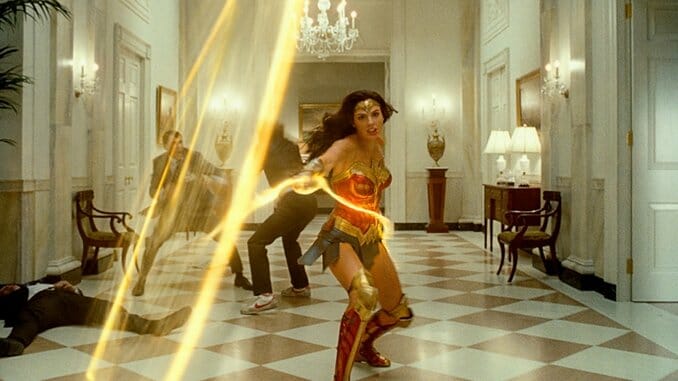Wonder Woman 1984 Lifts the DCEU a Little Higher Thanks to Gadot and a Golden Lasso

Well, that’s one way to tackle superhero movie fatigue. Thanks to COVID-19, Wonder Woman 1984 lands as just the year’s fourth big screen release in the genre. And, no offense to Bloodshot and New Mutants, it’s functionally just the second after February’s Harley Quinn: Birds of Prey. That means that, while Patty Jenkins’ anticipated sequel to the first DC extended universe (DCEU) success story has the usual challenges of pacing, plot and character development every director must solve, an audience over-saturated by costumed antics isn’t one of them.
Set 66 years after the previous film, Wonder Woman 1984 has many of the same strengths and weaknesses as its predecessor. Fortunately, the exact mix and proportion of those strengths and weaknesses has shifted for the better.
Casting and character development remain a core pillar of the franchise. As pure casting alchemy, Gal Gadot’s turn as everybody’s favorite Amazonian princess is matched only by Chris Evan’s as everybody’s favorite super soldier. (Respectful nod to Hemsworth’s Thor and Robbie’s Harley Quinn.) With the return of Chris Pine’s Steve Trevor, the simple, affable chemistry between the two is also back. The way in which Pine returns is one of several “Hm … nicely done” moments in the film (invisible jet!).
As crucially, when it comes to presenting viewers with her particular corner of the DCEU, Jenkins does so many of the little things well. That may seem like faint praise, but failure to handle the small moments well, or at all, has been a huge, hobbling issue for the DCEU even as it’s been a cornerstone of the MCU’s success. In part, moments like totally avoidable tornadic-assisted suicides, blasé infliction of collateral damage and straight up murder land so wrongly because they reveal fundamental misunderstandings of the characters involved. The success of the MCU’s Captain America is due in large part because, as much attention as is given to Cap during the action set pieces, as much or more is paid to Steve Rogers during the smaller moments. The same is true here.
At two hours, 31 minutes, Wonder Woman 1984 will inevitably draw some criticism for being slow in stretches, but it’s in these moments that Jenkins, Geoff Johns and Dave Callaham allow Gadot’s Diana and the other characters in the film to breathe and develop. It’s the kind of patience that may frustrate viewers looking for wall-to-wall action—or even just wall-to-wall Wonder Woman—even as it deepens the portrait of what it might be like to be a near-immortal force for justice whose true love perished decades ago. (The film also takes so much time transforming Kriten Wiig’s Barbra Minerva into a villain that the film feels like it’s setting up a Cheetah franchise.)
-

-

-

-

-

-

-

-

-

-

-

-

-

-

-

-

-

-

-

-

-

-

-

-

-

-

-

-

-

-

-

-

-

-

-

-

-

-

-

-








































